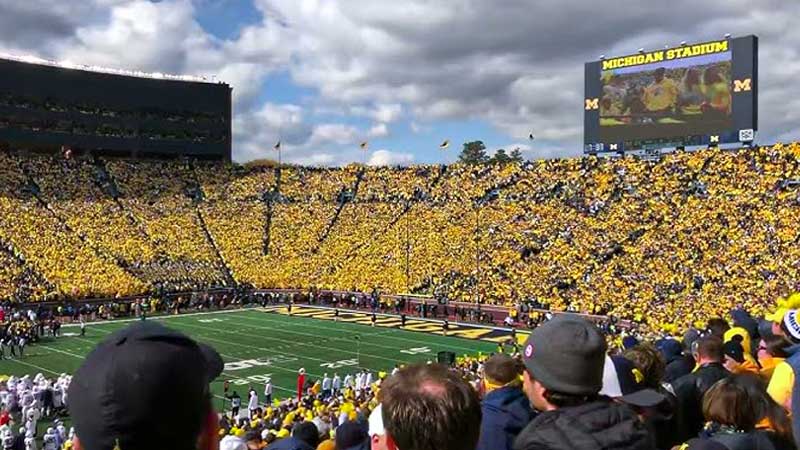College football is a sport celebrated for its fierce rivalries, thrilling plays, and the unyielding spirit of its fans. At the heart of this fervor lie the monumental football stadiums that serve as the grand stages for these gridiron battles.
In this blog post, we’ll take a closer look at the top 5 biggest college football stadiums in the United States, exploring their massive seating capacities, and rich histories.
We will also deal with the unparalleled atmosphere that makes them iconic venues for the college football community. So, stay strong till the end.
Top 5 Biggest College Football Stadiums
College football stadiums are more than just massive structures; they represent the heart and soul of the sport, where thousands of passionate fans gather to witness epic battles on the gridiron.
In this list mentioned below, we’ll explore the five biggest college football stadiums in the United States, where traditions, history, and camaraderie converge to create unforgettable game-day experiences.
1. Michigan Stadium (Ann Arbor, Michigan)
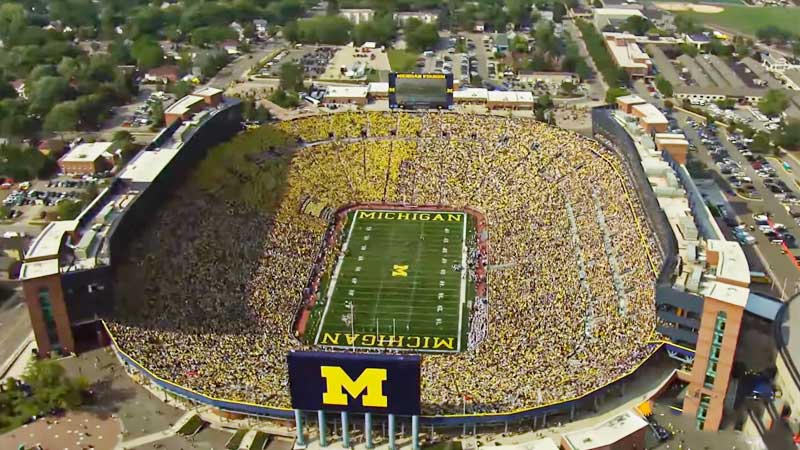
Michigan Stadium, often referred to as “The Big House,” is the largest college football stadium in the United States. With a seating capacity of over 107,000, it holds the record for the highest attendance in college football history.
The stadium’s unique bowl design and tiered seating offer unobstructed views from every angle, enhancing the fan experience.
Historical Significance
Built-in 1927, Michigan Stadium has a rich history and has witnessed countless legendary football games. It has been the home of the University of Michigan Wolverines for decades, creating an unmatched tradition and sense of pride for the team and its fans.
Game-Day Atmosphere
The sheer size of Michigan Stadium makes game days an unforgettable experience. The roaring crowd, maize, and blue colors, and the University of Michigan marching band all contribute to an electrifying atmosphere that reverberates throughout the stadium.
2. Beaver Stadium (State College, Pennsylvania)
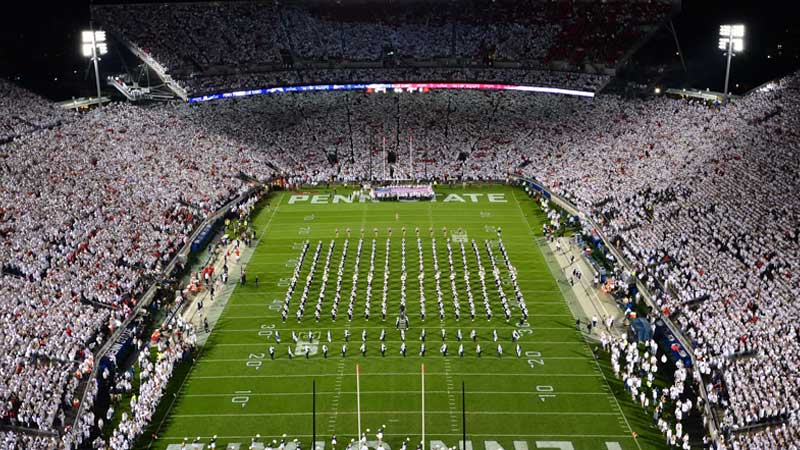
Beaver Stadium, the home of the Penn State Nittany Lions, is the second-largest college football stadium in the United States. It boasts a seating capacity of over 106,000, making it one of the largest venues in college athletics.
The stadium’s bowl design and massive video boards provide an immersive experience for fans.
White Out Games
One of the most iconic traditions at Beaver Stadium is the “White Out” game, where fans dress in all white to create a sea of white in the stands. This spectacle of unity and passion adds to the stadium’s allure and showcases the loyalty of the Penn State faithful.
Impact on the Community
Beaver Stadium’s immense size and capacity have a significant impact on the community of State College, Pennsylvania.
On game days, the stadium becomes the focal point of the town, attracting thousands of fans from across the region, boosting local businesses, and creating a sense of camaraderie among residents.
Hosting Historic Games
Beaver Stadium has been the site of numerous historic games, including epic matchups against rival teams and championship showdowns. The stadium’s imposing presence adds to the drama and excitement of these pivotal moments in college football history.
3. Ohio Stadium (Columbus, Ohio)
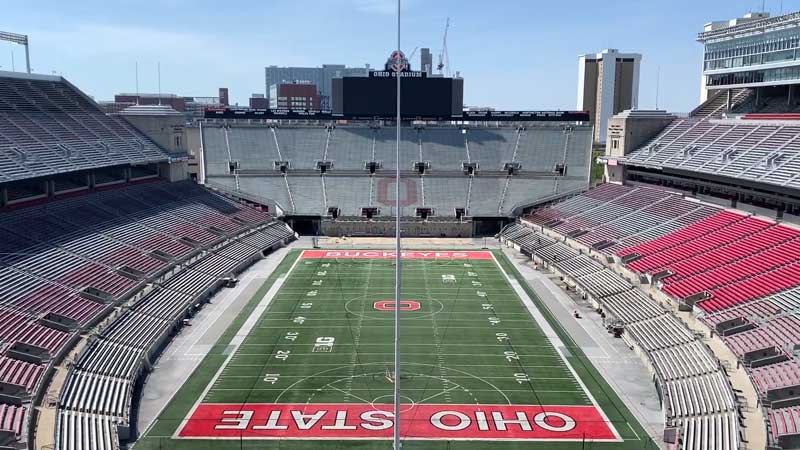
Ohio Stadium, fondly known as “The Horseshoe,” is the crown jewel of Ohio State University and a cherished symbol of Buckeye football. Built-in 1922, this iconic venue has witnessed over a century of college football history, hosting countless legendary games and iconic moments.
Capacity and Structure
With a seating capacity of over 102,000 fans, Ohio Stadium stands as one of the largest football arenas in the nation. Its horseshoe-shaped design allows for an awe-inspiring atmosphere that amplifies the noise of the passionate Buckeye faithful.
Game-Day Experience
The palpable energy within Ohio Stadium on game day is electrifying. The stadium’s rich traditions, such as the “Script Ohio” formation by the Ohio State Marching Band, create an unforgettable experience for fans and players alike.
4. Kyle Field (College Station, Texas)
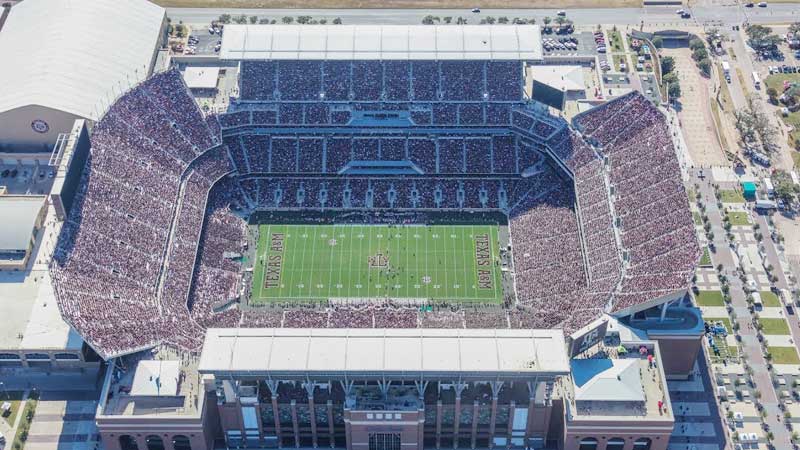
Located at Texas A&M University, Kyle Field is synonymous with the 12th Man tradition—a tribute to the school’s loyal fans who stand ready to support the team on the field at any moment. This spirit embodies the essence of Aggie football.
Expansion and Capacity
Originally constructed in 1927, Kyle Field has undergone multiple renovations, with the latest one completed in 2015. Today, the stadium boasts a capacity of over 102,000, making it one of the largest football stadiums in the country.
Renowned Atmosphere
The ambiance at Kyle Field is unparalleled. The Aggie War Hymn echoes throughout the stadium, creating an electrifying environment that fuels the players and energizes the fans.
5. Tiger Stadium (Baton Rouge, Louisiana)
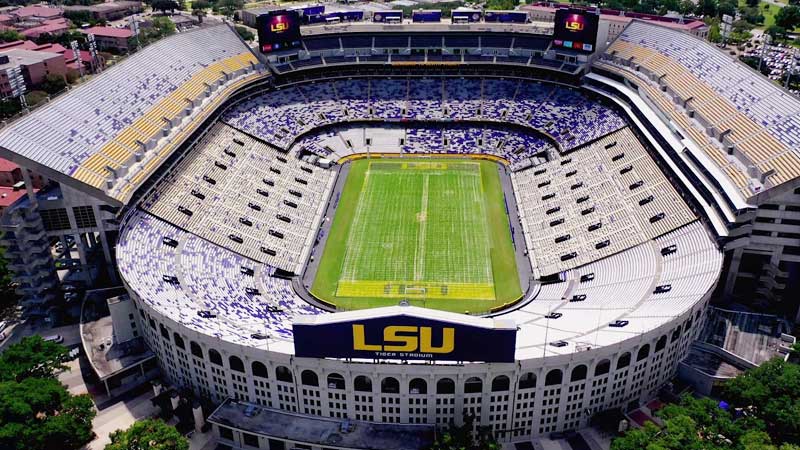
Tiger Stadium, commonly referred to as “Death Valley,” is the imposing fortress of Louisiana State University. Its nickname originates from the deafening noise created by the boisterous fans, which shakes opponents to their core.
Expansive Crowd
With a seating capacity exceeding 102,000, Tiger Stadium ranks among the largest and most intimidating college football venues in the country. The fervent LSU fan base, known for their “Geaux Tigers!” chant, adds to the stadium’s raucous atmosphere.
Night Games Magic
Tiger Stadium is renowned for hosting epic night games, where the aura of the stadium becomes truly magical. The Saturday night matchups under the bright lights of Death Valley are legendary in college football lore.
These monumental arenas stand as symbols of tradition, history, and the unifying power of the sport.
Each stadium has its unique identity, but they all share a common thread—the ability to transcend the game itself and become beacons of pride for their respective universities and the college football community at large.
Top College Football Stadiums Selection Criteria
The selection criteria for top college football stadiums consider several key factors. First and foremost is the stadium’s seating capacity, as larger venues can accommodate more passionate fans and create a more electrifying atmosphere.
The stadium’s historical significance and iconic traditions play a pivotal role, as do the overall game-day experience and fan engagement. Additionally, the stadium’s impact on the local community, its economic influence, and its role in fostering school spirit and alumni relations are considered.
Finally, media exposure and pop culture representation can contribute to a stadium’s recognition and status as one of the top venues in college football. Combining these factors helps identify the most prestigious and influential college football stadiums across the nation.
Cultural Impact of Large College Football Stadiums
College football stadiums are more than just massive structures hosting games; they serve as cultural epicenters that leave an indelible impact on their communities and the broader college football culture.
Here, we explore the profound cultural significance of these colossal venues and how they shape the fabric of American college football.
Unity and Identity
Large college football stadiums serve as rallying points for fans, students, and alumni, fostering a sense of unity and identity within the university community.
The stadium becomes a symbol of pride, where people from diverse backgrounds come together to support their team and alma mater.
Tradition and History
These stadiums are steeped in tradition and history, with generations of fans passing down their love for the team and the game.
Iconic traditions, like the Wisconsin “Jump Around” or the Texas A&M “12th Man,” become integral to the college football experience, creating an atmosphere of nostalgia and reverence.
Economic Impact
The economic impact of large college football stadiums extends far beyond game days. Hosting thousands of fans fuels local businesses, generating revenue for restaurants, hotels, and shops.
The economic boost from college football weekends can be transformative for the surrounding communities.
Recruitment and Admissions
The presence of a massive football stadium can influence prospective students’ decisions to attend a university.
The thrill of game days and the camaraderie displayed by fans can leave a lasting impression, shaping the overall perception of the university and contributing to increased admissions.
Community Engagement
Large college football stadiums offer opportunities for community engagement beyond game days. Universities often host events, fundraisers, and charity drives within these spaces, fostering a sense of community involvement and social responsibility.
Amplifying School Spirit
The electric atmosphere of a packed stadium can amplify school spirit to unparalleled heights. As fans cheer in unison, the team’s performance becomes intertwined with the university’s identity, igniting a collective passion that extends well beyond the field.
Alumni Relations
For alumni, revisiting the stadium evokes fond memories of their college days and creates opportunities for reconnection. The stadium becomes a hub for alumni reunions, homecoming celebrations, and shared experiences that strengthen alumni relations.
Media and Pop Culture
Large college football stadiums often play a significant role in media coverage and pop culture representations of college football. Iconic stadiums become recognizable symbols of the sport, frequently featured in films, television shows, and commercials.
Legacy and Legends
These colossal venues are the stages where college football legends are made. The feats accomplished in these fields become part of the sport’s folklore, contributing to the legacy of both players and the teams they represent.
Pride and Emotional Attachment
The cultural impact of large college football stadiums goes beyond sports. For many, these stadiums evoke a deep emotional attachment to their university, becoming a cherished part of their life’s journey and leaving a lasting legacy for future generations.
The Biggest college football stadiums are cultural powerhouses that transcend the boundaries of sports.
They are hallowed grounds where tradition, passion, and community converge, leaving an enduring impact on the cultural fabric of college football and the people who call these stadiums home.
FAQs
What are the criteria for determining the biggest college football stadiums?
The size of college football stadiums is determined by their seating capacity, with the largest stadiums accommodating tens of thousands of fans. The stadiums listed here are ranked based on their maximum seating capacity during football games.
How do these stadiums compare to professional football venues in terms of size?
While some of the largest college football stadiums rival or even exceed the seating capacities of certain professional football stadiums, the majority of NFL stadiums are larger due to the higher demand and revenue generated by the professional league.
Do these stadiums host other events besides college football games?
Many of these stadiums host a variety of events, such as concerts, other sports competitions, graduation ceremonies, and community gatherings, making them versatile spaces that contribute to their prominence within their communities.
How do these stadiums impact the college football experience for fans and players?
The massive size and electric atmosphere of these stadiums elevate the college football experience for both fans and players. The roar of the crowd and the sea of passionate supporters create an unforgettable backdrop for every game.
Are the attendance numbers consistent for each stadium, or do they fluctuate based on team performance?
Attendance numbers can fluctuate based on various factors, including team performance, game importance, opponent, and weather conditions. Successful teams and high-stakes matchups often attract larger crowds.
Bottom Line
The top 5 biggest college football stadiums stand as colossal monuments to the unwavering dedication of college football fans and the indomitable spirit of the sport.
These iconic venues have witnessed countless historic moments, uniting communities and creating lasting memories for generations of fans.
As epicenters of tradition and excitement, these stadiums remain integral to the essence of college football, symbolizing the unity and passion that make the sport a cherished American institution. Thank you for supporting us.

